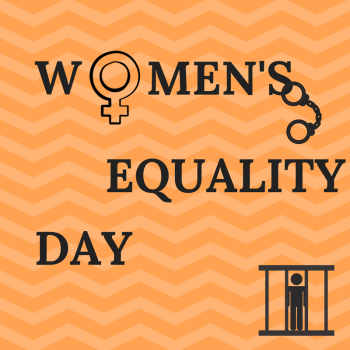Women’s Equality Day: Commemorating Progress While Fighting to Fulfill the Promise of Equality for ALL Women
Posted in 2017, Across the Country Thursday, 17 August 2017

By Anne-Lise Vray, Communications Associate
On August 26, we celebrate Women’s Equality Day, in “commemoration of that day in 1920, on which the women of America won their right to vote, as an opportunity to continue to work for equal rights for ALL citizens.” While this is a day to celebrate and women have made many strides, we still have room for improvement to achieve equality for all. The treatment of incarcerated girls and women in the criminal justice system is certainly one of those areas.
Girls and women in the justice system are exposed to great dangers and face incredible challenges that urgently need to be addressed. While various reasons can take girls down the incarceration path, violence, sexual abuse and trauma are among the most prominent factors for justice-involved women. Rates of sexual abuse are more than 4 times higher for girls in the system than for boys. According to a 2009 study conducted in South Carolina, 81% of girls in the juvenile justice system reported past sexual abuse. Nationally, approximately 73% of all juvenile justice involved girls have histories of physical and sexual abuse. And just like in other populations of the justice system, women and girls of color are disproportionally affected. While black girls only represent 14% of the youth population, they make up for 33% of girls’ arrests. Native American girls are 1% of the youth population, but 3.5% of girls’ arrests. Latina girls are confined at a rate of 47 per 100,000 compared to non-Hispanic, white girls who are confined at a rate 37 per 100,000.
Once behind bars, things are likely to only get worse for girls and women, who often find themselves in a system and facilities designed by and for men. In addition to the lack of access to essential goods such as menstrual products, they are forced to navigate a system that often does not address their trauma, and can even make it worse. A 2009 study of girls entering the justice system revealed that 22% of them had been sexually assaulted in the past 7 days. Yet upon intake, girls often have to go through invasive searches and physical restraints including shackling, which can be especially damaging for children with extensive histories of sexual abuse.
Queer and transgender women also face a great share of disparities when it comes to the justice system. Youth who identify as lesbian, gay, bisexual, transgender, or gender non-conforming (LGBT/GNC) are overrepresented in the justice system, constituting 20% of youth in detention across the country (over twice their numbers in the general population), at least 85% of which are youth of color.
Today, as we remember the progress accomplished for women’s rights, and we look forward to the numerous battles remaining in the fight for equality and equity, let us not forget the most vulnerable and discriminated groups among us. Justice-involved women’s rights are human rights, too.

